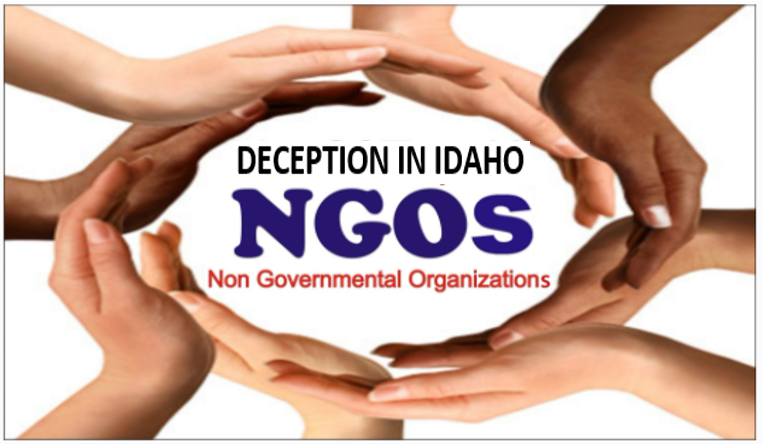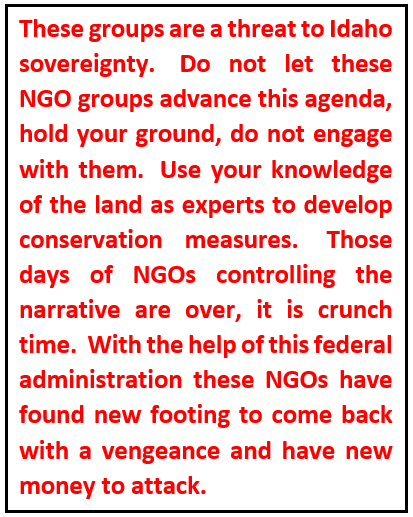
Renewed Threats To Idaho
By Karen Schumacher
With the current administration promoting its America the Beautiful plan there will be a renewed effort by non-governmental organizations (NGO) to pursue as much land as possible for conservation in meeting the 30×30 objectives laid out in the plan. That goal is conserving 30% of land and oceans in the United States by 2030. NGOs are clamoring over each other to get on board.
 NGOs in Idaho are notorious for presenting themselves as “collaborators” with Idaho citizens when in truth they favor NGO members from other groups, allow individuals outside of jurisdictional boundaries to participate in decisions that should be made only by citizens within a jurisdiction, dismiss citizen input, re-frame ideas to hide what is really being done, while all along playing a game of we are getting along and being inclusive of all opinions.
NGOs in Idaho are notorious for presenting themselves as “collaborators” with Idaho citizens when in truth they favor NGO members from other groups, allow individuals outside of jurisdictional boundaries to participate in decisions that should be made only by citizens within a jurisdiction, dismiss citizen input, re-frame ideas to hide what is really being done, while all along playing a game of we are getting along and being inclusive of all opinions.
Starting at the top with organizations that are umbrellas for smaller NGOs in order for those smaller NGOs to hide their comradery on objectives without coming out and actually saying they are supporting them, there are a few with massive power and money.
The Center for Large Landscape Conservation (CLLC) is global, run by Gary Tabor who has his fingers in most other NGOs, with bigger partners, even legislators, that help advance the cause. One such partner is the Salazar Center that recently held a symposium on the 30×30 plan that included government officials, Al Gore, global conservation groups, and other countries.
Fiscally sponsored by CLLC, another front group for smaller NGOs is the Network for Landscape Conservation (NLC) which includes the federal government, foundations, and universities as partners. The Salazar Center Director is on the Coordinating Committee, along with Gary Tabor, and representatives from the U.S. Fish & Wildlife (USFW) and U.S. Forest Service (USFS). NLC was also recently part of a rally that included discussions on 30×30.
Yellowstone to Yukon (Y2Y) is a large NGO that participates in and supports 30×30 as a partner to the above groups, along with more global entities, and covers transboundary objectives by mirroring Canada Target 1. It captures many of the smaller NGOs through partnerships such as the Idaho Conservation League (ICL), Idaho Wildlife Federation (IWF), Henry’s Fork Wildlife Alliance (HFWA), High Divide Collaborative (HDC), Salmon Valley Stewardship (SVS), and the Idaho Transportation Department (ITD) (as a side note Y2Y wanted to tear up a treasured mountain pass with wildlife overpasses even though the vehicle collision numbers did not justify it. Manipulating data is part of the Y2Y methodology). And yes, contrary to the statements made in the above report, along with CLLC and Gary Tabor, Y2Y is a member of the United Nations International Union for Conservation of Nature (IUCN), which supports 30×30. However, it is never enough for the UN and IUCN, even Y2Y, eventually this call for conservation will expand to 50%.
All of these smaller Idaho NGOs support the 30×30 objectives that drain down to them from the upper echelon in the larger NGOs, without ever having to voice that support, giving the appearance of no involvement. These small NGOs are just as much of a threat to Idahoans as any larger group and money is poured not only into these groups directly but also into the larger groups that feed that money down to the smaller ones. There are many others not mentioned here all working to accomplish the lofty goal of 30×30 which will eventually explode to 50×50. Plus, there is always the extremely wealthy groups like the Wyss Foundation that has already increased its contribution to $1.5 billion to conserve 30% of the land and giving grants to NGOs such as Y2Y.
State Senators Rabe and Wintrow, Representative Necochea, a few city council members and commissioners, and even Mayor McLean support 30×30. As Western Caucus members both Rep. Russ Fulcher and Rep. Mike Simpson are questioning the motives behind the 30×30 plan while Sen. Risch and Sen. Crapo have created an alternative plan based on “western conservation principles“. That is almost as vague as the 30×30 plan and includes “non-federal partners”, code word for NGOs.
A lame study by the American Center for Progress (CAP), using the IUCN World Database on Protected Areas and PAD-US, determined only 12% of land was protected. The 12% includes land that is currently under protection so that means another 18%, or 437 million additional acres, will be pursued for protection, more than twice the size of Texas. HR1755, HR803, and SB192 are all sitting in Congress, ready to take more land for non-use in the 30×30 scam.
So what can be done? How can these NGOs be thwarted in their strategic plans?
First, always remember that our Republic was founded on the principles of local government and jurisdictional boundaries. Idaho has 44 counties with as many jurisdictional boundaries. Every activity that occurs within those boundaries are determined by county commissioners, elected by the citizens of those counties. They must answer to you, not the federal government, not the state, not to NGOs, or to citizens who live outside of the county. Commissioners are accountable to the constituents who elected them. This is the same with cities.
If an NGO group moves into the area to start forming their prefabricated groups for “collaboration”, create your own group made up only of county citizens. Whatever the issue is, citizen groups should be the ones who are making the decisions, not NGO members or individuals from other counties. Make sure your Commissioners understand they are accountable to you for the decisions they make. If they do not comply with your decision effectively initiate a campaign to remove them from office.
Understand the law at both a state and federal level. One of the striking problems we have now is that governments at all jurisdictions tend to not follow the law. Violations in following the law have occurred at the state and federal level so there is no reason it doesn’t also occur at the county or city level. It might be the responsibility of the group to divide those laws up for researching as it can be quite cumbersome, and dry. But the more citizens understand the law, the better it is in holding the elected officials accountable. In the process they may even learn something they didn’t know.
These groups are a threat to Idaho sovereignty. Do not let these NGO groups advance this agenda, hold your ground, do not engage with them. Use your knowledge of the land as experts to develop conservation measures. Those days of NGOs controlling the narrative are over, it is crunch time. With the help of this federal administration these NGOs have found new footing to come back with a vengeance and have new money to attack.
Idahoans have already tolerated enough from the federal government on land issues, from poor forest management to expanded non-use. These renewed threats are significant. It is time to stop this forward movement now and it can be done within the boundaries of laws, but citizen authority must be exercised.